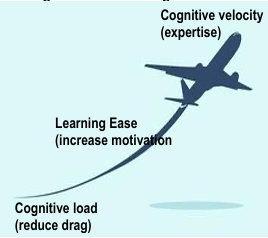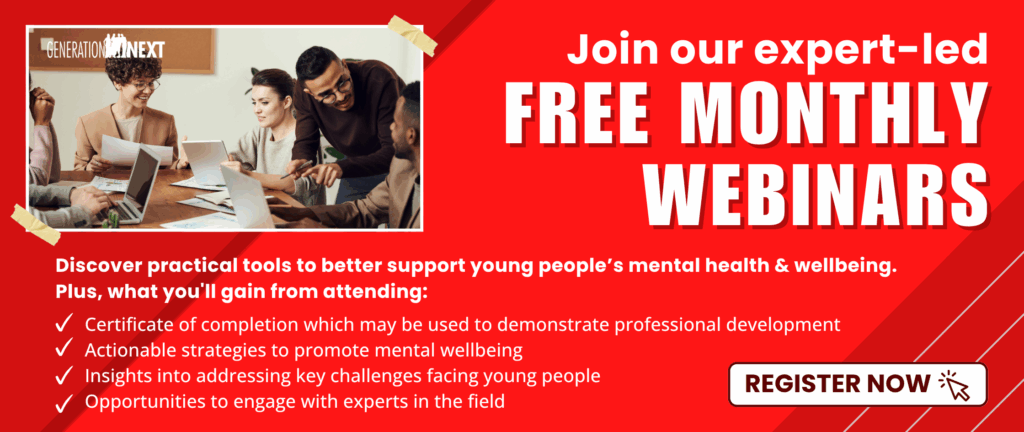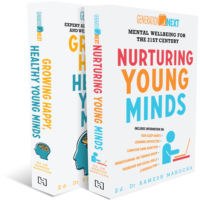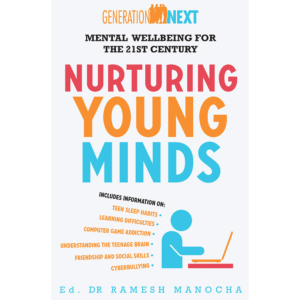Cognitive Load -> Learning Ease -> Cognitive Velocity
When we expand our knowledge from reducing cognitive load towards enhancing learning ease and engagement, and ultimately to increasing cognitive velocity, teaching becomes creative, exciting and impactful. We gradually coach our learners to shift from beginners to competence, and then, towards creative, innovative thinking.
This paper summarises the main strategies as we shift from load to velocity. Cognitive velocity involves depth as well as speed of learning. It involves constructing mastery and expertise.
The Flight Path of Learning

Coaching students starts with overcoming hurdles facing the new learner mind by reducing load and then builds ease to increase engagement, motivation and accelerate progress before using strategies that develop expertise.
Cognitive Load
Considerable focus has been given to the reducing the complexity of learning to avoid overloading learners brains. Prominent researchers on load include Sweller, Anderson, & Dunlovsky.
Cognitive load is like a traffic jam in the brain—everything slows down, emotions fray, and momentum stalls. If cortisol and adrenaline are high, fear of failure decreases learning. To prevent this, we need consistent and clear designs for curating learning.
Minimising cognitive load involves a series of strategies including:
- Awareness of working memory limits
- Deliberate practice and spaced repetition
- Segmentation of skills into basic components
- Retrieval practice and the testing effect
- Feedback loops for metacognitive growth
- Developing attention and engagement
- Dual coding theory (visual + verbal input)
- High repetitions, low stakes
- Spaced learning followed by ‘sleep-on-its’
- Worked examples, where learners complete the last step and then progressively work backwards towards completing whole tasks (backward chaining)
The purpose of reducing cognitive load is to increase the likelihood of success in beginning learners.
Reducing cognitive load makes it easier for brains to develop initial understandings and skills. It helps learners to make fewer mistakes, but we don’t need to stop there, we want our learners to be creative and innovative.
Learning Ease
The approaches to reducing the load of learning are different processes than those involved in creating learning ease.
The middle phase of learning is the most precarious. Challenges increase, complexities are introduced and if this overwhelms the learner, they disengage rather than feeling like a failure. Guiding learners through this stage while increasing their skill level is the true art of coaching and teaching.
Curating success becomes contagious. It builds resilience and courage in learners and accelerates learning.
Learning ease is like the sense of ‘flow’ where challenges are engaging and learning is absorbing. Prominent researchers include Csikszentmihalyi, Dweck, Immordino-Yang, Mayer, and Sapolsky.
As learners develop competence, we shift our teaching strategies accordingly. This is similar to coaching, where the approaches to skill-up players new to a game, are different from those needed for more experienced players.
Some strategies that increase learning ease and the trajectory of a learner’s development include:
- Reps remain high and stakes are increased
- Struggles are reframed as experiments
- Serotonin (a sense of contentment and ease) is alternated with dopamine (a sense of anticipation and reward)
- Cortisol levels are lowered, otherwise hippocampal functioning and working memory are impaired
- Adrenaline is regulated. This increases alertness but narrows thinking and constricts complex reasoning
- Organising knowledge into patterns and schema and note making expands the limits of working memory
- Pattern recognition becomes more prominent especially the identification of similarities and differences
- Starting with learning strengths increases motivation
- Multisensorial learning increases depth of encoding knowledge
- Worked examples are still used but there are increased variations within them to encourage flexible application of ideas and skills in different settings
The importance in designing for learning ease is that some learners experience a mid-point struggle in understanding new concepts and if we don’t make it engaging to keep going, they give up.
We need to make it exciting to take on challenges and give our learners gain a sense of progress within their first three attempts.
Learning ease becomes contagious. It shifts learners from fearing mistakes and playing safe to feeling supported to take risks, build strengths and develop a have-a-go mindset.
Learning Velocity: Thinking at the Speed of Insight
Designing learning now shifts from clarity and simplicity to faster, deeper, and more transferable learning. Prominent researchers on expertise and learning velocity include Ericsson, Colvin-Clark, Craik & Lockhart, Hatano, Perkins, Roediger & Karpicke.
To increase learning velocity, we design learning experiences like a flight path— reducing drag (cognitive load), building lift (engagement + memory), and then accelerating forwards (transfer + fluency). We want our learners to soar.
A different set of methods are needed to create this level of learning. For example, the methods that are effective in helping children to first read and write are different than those that create a fully literate person.
Cognitive velocity is like a musician riffing and improvising on a theme or a surgeon having to shift strategies mid-operation. This is expertise at a high level, thinking, retrieving and applying knowledge in varied ways. It is purposeful play.
Knowing the basic processes is necessary but not sufficient in life and we want people to be life-long learners.
Developing cognitive velocity involves creating deep reflection and connection between ideas, creativity and the building of expertise.
AI may replace jobs that are easily automated. It is the skills of flexibility, creativity and deep thinking that will be most valued in the future.
Cognitive velocity involves thinking:
- Conceptually and analytically
- Creatively
- Critically
- Flexibly
- Persuasively
- Metacognitively
The strategies that help learners to solve problems on-the run, include:
- Ask students to try solving an issue before showing them how. Encourage having a go, ‘think- alouds’ and team problem solving. Experts spend more time than beginners on analysing problems before they solve them.
- Enriching dual coding (visual + verbal) by having learners draw concepts and creating maps and visual metaphors to represent and link complex ideas.
- Metacognitive training with reflection points-
- What helped me learn this?
- Where did I get stuck?
- What else could I try?
- Rich mental models and schema. Encourage thinking in patterns. This broadens the bandwidth of working memory.
- What does this remind you of?
- What is it similar to?
- Can we create an analogy?
- Develop cognitive flexibility and transfer – use case or scenario-based learning.
- Promote interleaving of different problem types. This slows learning but improves long- term transfer in unfamiliar contexts.
- Attention training- deep thinkers don’t attend to everything, they focus on the right things quickly. Reduce distracting, extraneous stimuli (especially for neurodivergent learners). Help reduce mind-wandering.
Attention training develops skills to gain and sustain focus and to resist the distractions of devices. - Retrieval practice (low stakes quizzes) improves access speed. Spaced repetition followed by sleep support consolidation. The brain’s search engine only works well when it’s been indexed well.
- Scenario-based learning helps learners synthesise different processes and to apply them to different situations.
- Socratic questioning. True understanding comes from questioning assumptions not memorising facts. Having great questions is more important than having good answers.
- What do I know for sure?
- What am I uncertain about?
- What follows if this it true?
- Creative transfer of learning- innovative problem solving and cognitive velocity require flexible understandings that go beyond the basic concept e.g.
- What is the underlying principle?
- What is the deep structure here?
- What would this look like in another system- human, natural, or technological?
- What if this problem was in a different setting? In space? Underwater? 200 years ago?
- What if the answer is the opposite of what we expect? What could that look like?
The Teacher-Coach is Essential
The shift from cognitive load to learning ease to cognitive velocity all relies on one person- the teacher or coach. With a caring, confident and creative coach who can use different strategies to promote the best progress in each learner, this becomes an exciting voyage of personal development. Most of all, it requires teachers to solemnly pledge to
‘never underestimate the power of your learners’ brains.’
More information
For sessions that take teachers through the three stages- understanding cognitive load, creating and using learning ease and accelerating cognitive velocity, or on attention training, tailored to your setting, email: inyahead@aussiebb.com.au
Andrew’s website http://www.mylearningstrengths.com has helped over 200,000 young people discover their learning strengths.
Plus, visit www.andrewfuller.com.au
Book for Parents
- Neuroadvantage: The Strengths-Based Approach to Neurodivergence
- Approach to Neurodivergence
- Tricky Teens or Tricky Kids
- The A to Z of Feelings
- Unlocking Your Child’s Genius (Amba Press)
Book for Teachers
- Neuroadvantage: The Strengths-Based Approach to Neurodivergence
- Guerilla Tactics for Teachers
- Tricky Behaviours
- Tricky Conversations
- Tricky Teens
- Unlocking Your Child’s Genius
- Neurodevelopmental Differentiation- Optimising Brain Systems to Maximise Learning (Amba Press)
Cognitive Velocity – Summary table of main strategies
| Cognitive Load | Learning Ease | Cognitive Velocity |
|---|---|---|
| Cater for the limits of working memory |
Expand working memory | Student-led problem solving with ‘think alouds’ |
| Deliberate practice | Increase serotonin | Enrich dual coding |
| Segment skills into basic components | Lower cortisol & adrenaline | Attention Training |
| Retrieval Practice | Differentiate using strengths | Metacognitive training |
| Feedback to grow metacognition | Patterns, schema & note making | Enrich mental models & schema |
| Increate attention & engagement | Learning strengths | Cognitive flexibility & transfer skills |
| Dual coding (visual + verbal) | Multisensorial learning | Retrieval practice |
| High reps, low stakes | High reps, higher stakes | Scenario-based learning |
| Spaced learning | Build a ‘have-a-go’ mindset | Socratic questioning |
| Worked examples & backwards chaining | Worked examples with more variations | Creative transfer of learning |








